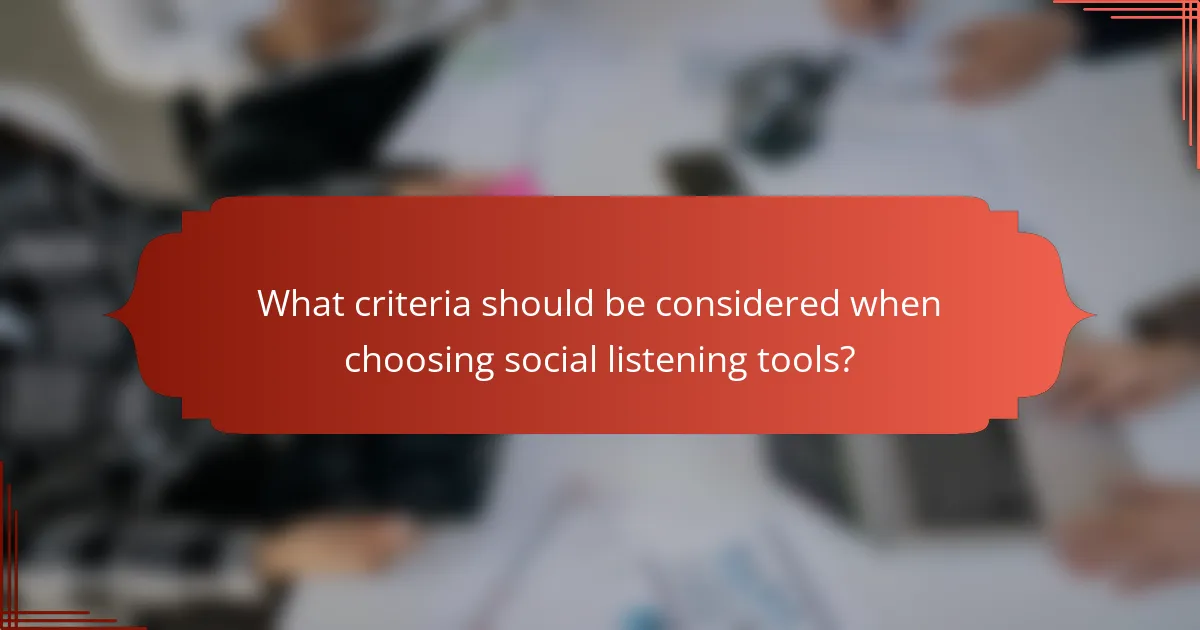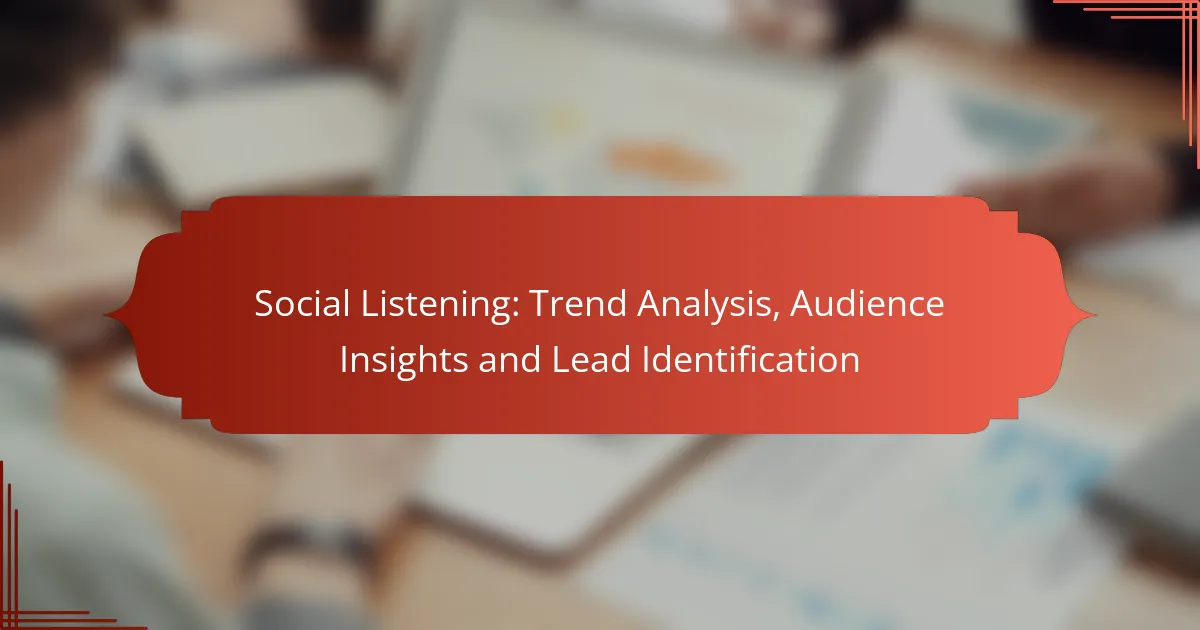Social listening is a powerful tool for businesses in the UK, enabling them to analyze online conversations and identify potential customers while gauging their sentiments. By leveraging advanced technologies and artificial intelligence, brands can uncover key trends and gain valuable audience insights, allowing for more targeted outreach and improved marketing strategies that resonate with their target audience.

How does social listening identify leads in the UK?
Social listening identifies leads in the UK by analyzing online conversations to uncover potential customers and their sentiments. This process helps brands understand audience needs and preferences, allowing for targeted outreach and engagement.
Lead generation through sentiment analysis
Sentiment analysis involves evaluating the emotions behind social media posts and comments to gauge public opinion about a brand or product. By identifying positive, negative, or neutral sentiments, businesses can pinpoint leads who express interest or dissatisfaction, offering opportunities for engagement. For example, a brand might reach out to users expressing frustration with a competitor’s product, presenting their own solution.
Identifying potential customers via engagement metrics
Engagement metrics, such as likes, shares, and comments, provide insights into which users are actively interacting with content related to a brand. High engagement levels often indicate potential customers who are interested in a product or service. Brands can track these metrics to prioritize outreach efforts, focusing on users who show consistent interaction.
Utilizing social media platforms for lead discovery
Different social media platforms offer unique opportunities for lead discovery. For instance, LinkedIn is effective for B2B lead generation, while Instagram and Facebook can be leveraged for B2C interactions. Brands should tailor their strategies to each platform’s audience, using targeted ads and engaging content to attract potential leads.
Case studies from UK brands
Several UK brands have successfully utilized social listening for lead generation. For example, a well-known beverage company analyzed social media chatter to launch a targeted campaign aimed at health-conscious consumers, resulting in a significant increase in engagement and sales. Another retail brand used sentiment analysis to address customer complaints, leading to improved customer satisfaction and loyalty.

What are the key trends in social listening for UK businesses?
Key trends in social listening for UK businesses include the integration of advanced technologies, the growing influence of artificial intelligence, and notable shifts in consumer behavior. These trends enable companies to gain deeper audience insights, identify leads, and adapt to changing market dynamics.
Emerging technologies in social listening
Emerging technologies such as natural language processing (NLP) and sentiment analysis are transforming social listening. These tools allow businesses to analyze vast amounts of social media data quickly, extracting valuable insights about customer opinions and trends.
Additionally, platforms that utilize machine learning can continuously improve their analysis capabilities. This means businesses can stay ahead of trends by identifying patterns in consumer conversations and preferences more effectively.
Impact of AI on trend analysis
Artificial intelligence is significantly enhancing trend analysis in social listening by automating data collection and interpretation. AI algorithms can sift through millions of social media posts to detect emerging trends and shifts in consumer sentiment.
For UK businesses, leveraging AI tools can lead to more accurate forecasts and timely responses to market changes. Companies should consider integrating AI solutions to streamline their social listening efforts and enhance their competitive edge.
Shifts in consumer behavior
Recent shifts in consumer behavior, especially post-pandemic, have made social listening more critical. UK consumers are increasingly vocal about their preferences on social media, making it essential for businesses to monitor these conversations closely.
Understanding these shifts allows businesses to tailor their marketing strategies and product offerings. Companies should focus on engaging with their audience through personalized content and responsive communication to build stronger relationships and drive loyalty.

How can audience insights enhance marketing strategies?
Audience insights can significantly enhance marketing strategies by providing a deeper understanding of customer preferences and behaviors. By leveraging these insights, businesses can tailor their marketing efforts to better resonate with their target audience, ultimately driving engagement and conversions.
Target audience segmentation
Effective audience segmentation involves dividing your audience into distinct groups based on shared characteristics such as demographics, interests, or behaviors. This allows marketers to create targeted campaigns that speak directly to each segment’s unique needs and preferences.
For example, a clothing retailer might segment its audience into categories like age, gender, and style preferences, enabling them to send personalized promotions that are more likely to convert. Utilizing tools like social listening can help identify these segments based on real-time conversations and trends.
Personalization of marketing messages
Personalization involves tailoring marketing messages to individual consumers based on their preferences and behaviors. By using audience insights, marketers can craft messages that resonate more deeply, increasing the likelihood of engagement.
For instance, an email campaign that references a customer’s previous purchases or browsing history can feel more relevant and engaging. Techniques such as dynamic content in emails or personalized product recommendations on websites can enhance the effectiveness of marketing efforts.
Real-time feedback for campaign adjustments
Real-time feedback allows marketers to monitor the performance of their campaigns and make adjustments as needed. By analyzing audience reactions and engagement metrics, businesses can quickly identify what works and what doesn’t.
For example, if a social media ad is underperforming, marketers can tweak the messaging or visuals based on audience feedback. This agile approach helps optimize campaigns for better results, ensuring that marketing strategies remain aligned with audience expectations and trends.

What tools are essential for effective social listening?
Effective social listening relies on a combination of tools that provide insights into trends, audience engagement, and lead identification. Utilizing the right platforms can enhance your ability to analyze conversations and extract valuable data from social media channels.
Brandwatch for trend analysis
Brandwatch is a powerful tool for analyzing social media trends, allowing businesses to monitor brand mentions, industry conversations, and emerging topics. It aggregates data from various platforms, providing insights into sentiment, volume, and reach.
To effectively use Brandwatch, set up specific queries related to your brand or industry. Regularly review the analytics dashboard to identify shifts in consumer behavior and emerging trends. This can help you stay ahead of competitors and adapt your marketing strategies accordingly.
Hootsuite for audience engagement
Hootsuite excels in facilitating audience engagement by allowing businesses to manage multiple social media accounts from a single dashboard. It enables users to schedule posts, respond to comments, and track interactions across platforms.
To maximize Hootsuite’s potential, take advantage of its analytics features to monitor engagement metrics such as likes, shares, and comments. Regularly engage with your audience by responding promptly to inquiries and participating in conversations to build stronger relationships.
Sprout Social for lead identification
Sprout Social is effective for identifying leads through its robust social listening and analytics capabilities. It helps businesses track potential customers by monitoring keywords and conversations related to their products or services.
To leverage Sprout Social for lead identification, create keyword searches that align with your target audience’s interests. Analyze the data to pinpoint prospects and engage with them through personalized outreach. This proactive approach can significantly enhance your lead generation efforts.

What criteria should be considered when choosing social listening tools?
When selecting social listening tools, consider factors like integration capabilities, data accuracy, user interface, and pricing. These criteria will help ensure the tool meets your organization’s needs and enhances your social media strategy.
Integration capabilities with existing systems
Integration capabilities are crucial when choosing social listening tools, as they determine how well the tool can work with your current systems. Look for tools that can seamlessly connect with your CRM, marketing platforms, and analytics software to streamline workflows.
For example, a tool that integrates with Salesforce can help you track leads generated from social media conversations directly within your sales pipeline. Additionally, consider whether the tool supports API access for custom integrations, which can enhance flexibility and functionality.
Data accuracy and reliability
Data accuracy and reliability are essential for effective social listening. A tool should provide precise sentiment analysis and engagement metrics to ensure you are making informed decisions based on trustworthy data.
Check for user reviews and case studies that highlight the tool’s performance in real-world scenarios. Tools that use advanced algorithms and machine learning techniques often yield better accuracy, so prioritize those options.
User interface and ease of use
A user-friendly interface is important for maximizing the effectiveness of social listening tools. The tool should be intuitive, allowing team members to navigate easily and access insights without extensive training.
Consider requesting a demo or trial period to evaluate the user experience. A well-designed dashboard that presents data visually can significantly enhance your team’s ability to interpret and act on insights quickly.
Pricing and value for money
Pricing is a key factor when selecting social listening tools, as costs can vary widely based on features and capabilities. Assess your budget and the specific functionalities you need to ensure you get good value for your investment.
Some tools offer tiered pricing models, allowing you to choose a plan that fits your requirements. Be cautious of hidden fees for additional features or data access, and ensure that the pricing aligns with your expected return on investment.
